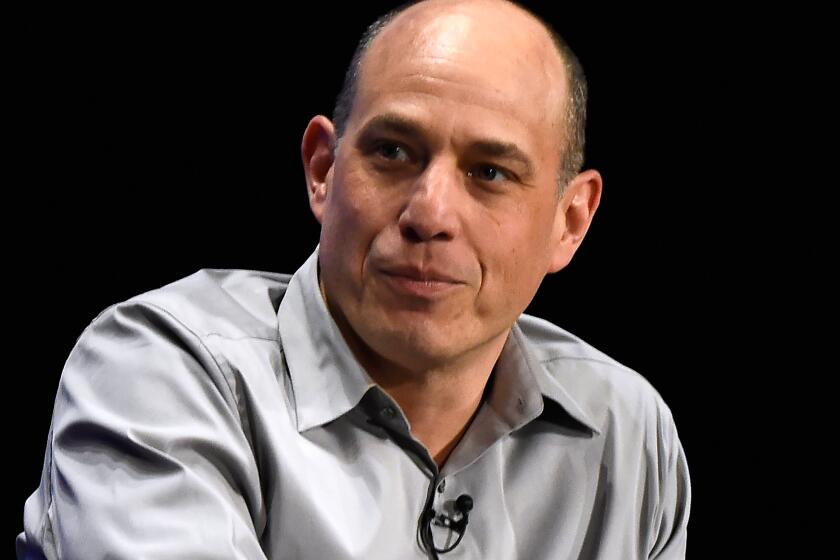Nora Ephron loved New York City in the fall — and it shows in her movies

- Share via
On the Shelf
'Nora Ephron at the Movies'
By Ilana Kaplan
Abrams: 224 pages, $50
If you buy books linked on our site, The Times may earn a commission from Bookshop.org, whose fees support independent bookstores.
The season has changed. The scent of pumpkin spice lattes is in the air and leaves are falling, even here in Southern California. Move over, Brat Summer — it’s time for Nora Ephron Fall.
Whereas the former was all chaos and crop tops, Nora Ephron Fall, depicted memorably in her most popular rom-coms, is a decidedly grown-up affair. It’s turtlenecks and quality sweaters, buying decorative gourds for an evening dinner party and coupling up for cuffing season, if not longer term.
“When we watch ‘When Harry Met Sally’ or ‘You’ve Got Mail,’ it distills this sweeping sentiment of being in New York City in the fall and this magical feeling that comes once a year, like Christmas,” “Nora Ephron at the Movies” author Ilana Kaplan says, invoking two signature films that she groups with “Sleepless in Seattle.” “We search for that feeling every year.”

Ephron, who was raised in Los Angeles by screenwriter parents but called New York City home as an adult, is known for films with humorous dialogue, complicated heroines and realistic elements of the city she loved. Manhattan’s Empire State Building notably plays a key role in “Sleepless in Seattle,” an Ephron homage to “An Affair to Remember”; like “When Harry Met Sally” and “You’ve Got Mail,” it stars Meg Ryan. (Rob Reiner directed “When Harry Met Sally” based on Ephron’s script, while she wrote and directed the other two.)
“I feel like the women in her work were always messy and more complex and they were quite flawed or not as buttoned up as the rom-com heroines of Hollywood’s golden age,” Kaplan says. “That character study has continued in rom-coms today.”
Bruce Eric Kaplan has turned his struggles getting a dream TV project off the ground during the pandemic into a comic primer about Hollywood called ‘They Went Another Way’
The genre had begun to fall out of vogue at the multiplex by the time Ephron died of cancer in 2012, but her ethos has lived on in work such as 2015’s “Sleeping With Other People,” last year’s “Anyone but You” featuring the palpable chemistry between stars Glen Powell and Sydney Sweeney, and this year’s age-gap rom-com “The Idea of You,” with Nicholas Galitzine and Anne Hathaway in leading roles. Kaplan also praises “Sex and the City” for taking the “When Harry Met Sally” Katz’s Deli orgasm scene — born out of a collaboration between Ephron, its filmmakers, Ryan and co-star Billy Crystal while making the 1989 film — and running with it in the show’s frank conversations about sex, as well as the controversial Netflix series “Nobody Wants This.”
But the author maintains Hollywood could make more rom-coms that move the needle the way Ephron’s movies did. “There have been some, but not all of them have quite cracked that formula,” Kaplan says, praising films that carry a similar element of humor or chemistry.

Beyond rom-coms, Kaplan’s book explores Ephron’s lesser-known films and screenplays, as well as her essays, the novel “Heartburn” and its movie adaptation — one of Kaplan’s favorites — and the cultural impact of her work. Ephron received three Oscar nominations for her screenplays, the first for “Silkwood,” followed by recognition for “When Harry Met Sally” and “Sleepless in Seattle.” “Julie & Julia,” her last film, received an Oscar nomination for Meryl Streep’s performance as Julia Child.
Among the surprises for the author while researching Ephron’s work: Her screenplay for the 1989 mobster comedy “Cookie,” directed by another pioneering female director, Susan Seidelman, and her producing credit on the cult teen movie “All I Wanna Do,” also known as “Strike!” or “The Hairy Bird.”
“You can be a fan of someone’s work and still not really know the breadth of it,” Kaplan says. “So it was really interesting for me to dig in and learn about not only Nora’s history and her life, but her friendships, her relationships with people, her mentees.”
The journalist turned filmmaker “was actually quite complex, much like the female heroines who weren’t necessarily endearing off the bat,” Kaplan says. “She was the rom-com queen, but I feel like if you read her work, she could be scathing and tough, harsh and critical. But those facets were what made her compelling and alluring to people.”
Kaplan is especially fond of a scene toward the end of “You’ve Got Mail.” Tom Hanks’ character Joe wonders why Ryan’s Kathleen won’t forgive him for putting her humble bookstore out of business but she will forgive the guy she’s been chatting with online — also him, unbeknownst to Kathleen — for standing her up. “Oh, how I wish you would,” Joe says.
“I get chills every time I hear that line,” Kaplan says.
The scene is reminiscent of a moment in “Sleepless in Seattle.” Rosie O’Donnell’s character tells Ryan’s Annie that she doesn’t want to be in love, she wants to be in love in a movie.
Preferably a Nora Ephron one.
More to Read
The biggest entertainment stories
Get our big stories about Hollywood, film, television, music, arts, culture and more right in your inbox as soon as they publish.
You may occasionally receive promotional content from the Los Angeles Times.











